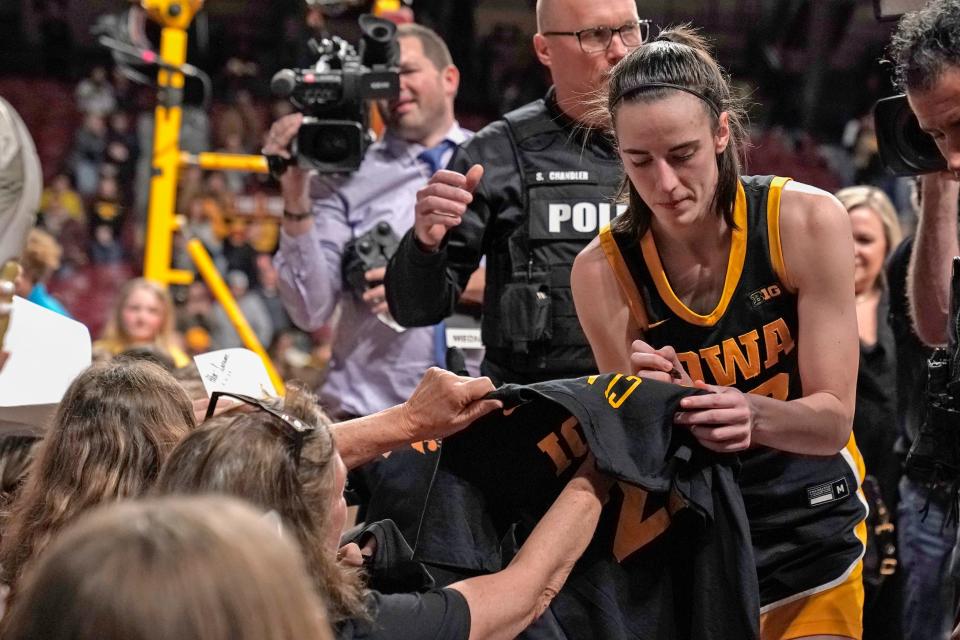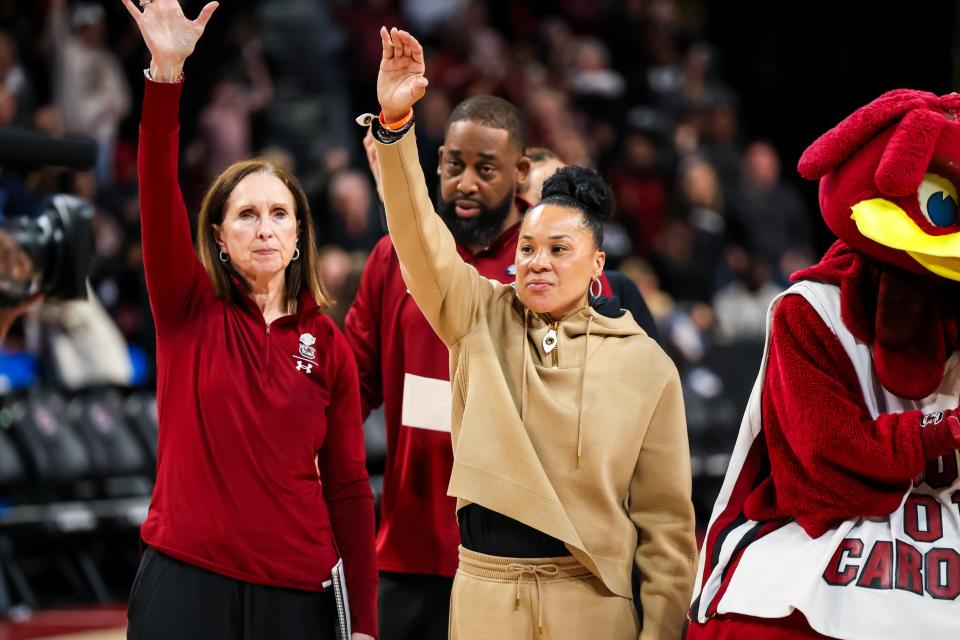Can Caitlin Clark’s surge be sustained for women's hoops? 'This is our Magic-Bird moment'
The culminating moments of this year’s NCAA women’s basketball tournament might go down in history as the time that changed the sport forever.
At least that’s how some prominent observers see it, 45 years after they saw the men’s game change forever with a different Final Four in 1979.
Consider the similarities.
Back then, it was Magic Johnson and Larry Bird. Their rising superstardom captivated the nation in the NCAA Tournament, breaking a record for television viewership and setting the stage for explosive growth in the men’s game before moving on to save the NBA.
This year, it’s Caitlin Clark of Iowa. She is also helping set new viewership records in the women’s game and could similarly bring new life to the WNBA this year after this weekend’s Final Four in Cleveland.
WNBA commissioner Cathy Engelbert has noticed.
“This is our Magic-Bird moment,” she told USA TODAY Sports Wednesday.
Former CBS Sports president Neal Pilson attended that game in '79 and sees parallels, too.
“Larry Bird and Magic − can that be replicated?” Pilson told USA TODAY Sports. “I’m not at all concerned that there won’t be a positive continuation of this type of attention… All this feeds on itself. It grows. It doesn’t just go away.”
Caitlin Clark and exposure
It’s not a perfect comparison. Magic vs. Bird exploded into a two-star college rivalry that culminated in the championship game. This year, Clark and Iowa beat defending champion LSU and rival star Angel Reese in the Elite Eight, drawing the biggest television audience in women’s college basketball history (12.3 million). Four days later, Clark plays in the Final Four Friday against Connecticut and Paige Bueckers, a guard her coach has described as “the best player in America.”
But the high-wattage appeal is similarly stirring to viewers, advertisers and even gamblers, helping the popularity “feed off itself” by raising the tide of exposure for all boats that benefit from it.

In 1979, Magic vs. Bird set a record with 35 million viewers. Now evidence shows a similar sort of national awakening in women’s basketball.
“I’ve been analogizing that to say this is our transformational moment like that was, which led to big media deals, with led to big marketing, i.e. Michael Jordan and Nike, the ultimate marketer,” Engelbert said.
Yet the women’s college game has had big audiences and stars before, in the 1980s and ‘90s, including Cheryl Miller and Sheryl Swoopes. Their tournament games also drew audiences of seven to 12 million on CBS when there were far fewer media channels and no social media. Huge growth didn’t follow.
“The question for me more is, `How sustainable is this?’” said Cheryl Cooky, a professor at Purdue who has co-authored a study on media coverage of women’s sports. “Is this another peak that’s going to be followed by a valley? Or is this truly sort of an upward trajectory where we see increases happening over time?”
This time might be different
For example:
◾ Two of the top four most-watched women’s college basketball games of all time featured Clark against Reese – last year in the final game (nearly 10 million on average) and Monday in the Elite Eight (12.3 million).
◾ Forty new advertisers are buying time in the women’s Final Four this weekend with ABC or ESPN. The Walt Disney Co., which owns ABC and ESPN, confirmed to USA TODAY Sports that inventory for those games sold out earlier than ever before. Disney also confirmed that revenue from those sales more than doubled from last year and has more than tripled over the past three years.
◾ GroupM, a prominent media investment group, announced last week a commitment to double investment in annual women’s sports advertising. It plans to do it with clients such as Adidas, Ally, Coinbase, Discover, Google, Mars, Nationwide, Unilever and Universal Pictures.
The company cited peaks in viewership and said it would collaborate with media partners to help “drive the discovery, promotion and monetization of women’s sports.“
◾ Gambling, which helps drive sports viewership, is also skyrocketing for women’s basketball and wasn't even legal in most of the nation until after May 2018. The betting handle on women’s college basketball is up 14 times more than last year as of March, according to DraftKings. The LSU-Iowa game Monday was the most bet-on women’s college basketball game in DraftKings Sportsbook history and was on par with many NFL games from last season in terms of betting handle.
“When you treat us like a sport, you will get a return on your investment,” said South Carolina coach Dawn Staley, whose undefeated team faces North Carolina State in the other national semifinal Friday. “Women's basketball is in high demand. People want to see it. People want to see it live, and people want to see it across the airways.”

'50 years in the making'
In other words, exposure and investment are peaking for women’s college basketball after decades of under-investment, neglect and occasional fits and starts.
By comparison, the men’s game has reaped the benefits of exposure and investment for decades longer. And it wasn’t until 1972 that Title IX banned sex discrimination in schools.
The first NCAA Tournament for the men came in 1939, compared to 1982 for the women, who previously competed for championships in the now-defunct Association for Intercollegiate Athletics for Women. By 1954, the men got their first national championship game on national TV, compared to 1982 for the women.
“Remember, we just celebrated the 50th anniversary of Title IX,” said former Georgia Tech coach Bernadette McGlade, now the commissioner of the Atlantic 10 Conference. “This has been 50 years in the making. It hasn’t been a flash in the pan just overnight.”
It still might seem like it sometimes. In 2019, the proportion of airtime devoted to women’s sports on sports news shows and ESPN’s SportsCenter was less than 6%, according to a study by the University of Southern California and Purdue. In 2021, a report commissioned by the NCAA found that the governing body of college sports “prioritizes men’s basketball” and it was "significantly undervaluing women’s basketball as an asset."
The NCAA didn’t even use the popular marketing term “March Madness” to promote the women’s game until 2022.
So what’s changing?
For starters, it helps to not keep under-promoting half of the potential marketplace by gender.
“Their superstars were not getting the kind of promotion they are getting today,” Pilson told USA TODAY Sports. “They and the industry have learned a lot from the NBA and NFL (which have been around longer). They’ve learned that the public responds to the athletes. They learned that the athletes are the shooting stars in their sport.”
The rise of social media and online streaming services also allowed women’s basketball to reach more people, as opposed to 30 years ago, when newspaper and TV companies essentially acted as gatekeepers of what sports got covered and what didn’t.
Sports editors and TV executives back then had limited space and time for coverage, forcing them to make choices. And they would try to justify the coverage disparity between men's and women’s basketball by pointing to the attendance figures. For example, in 1994, the Division I men’s game drew an average of about 5,500 compared to about 1,100 for the women, according to NCAA records.
But the reverse also could be true: Attendance lagged because the game wasn’t promoted like the men. Similarly, players on the great Tennessee and UConn teams of the 1990s and early 2000s might have gotten more national traction if TikTok, Instagram and other social media were around to connect them with more fans back then.
Endorsement deals help, too. They weren’t allowed for college players until 2021, but now they help brighten the spotlight for some star players, such as Clark with Nike and State Farm insurance.
But will it last?
This is where the Magic-Bird comparison faces its moment of truth. After Clark, will the women’s college game sustain this level of interest?
The men’s game exploded in popularity after Magic and Bird in the 1980s, especially after CBS won the television rights to the men’s tournament in 1982. Other stars and storylines came along to drive interest, pumping up the men’s postseason into the commercial behemoth it is now.
With Clark on the way to the WNBA, Bueckers and others are left to help carry it, including Southern California’s JuJu Watkins, a freshman who ranked second nationally in scoring this season behind Clark with 27.1 points per game.
The NCAA also has invested more but still needs to do more, according to supporters of the women’s game.
In the last three years, the NCAA has increased the investment in just some of the major championship areas for women’s basketball by more than $14 million annually, said Lynn Holzman, the NCAA’s vice president of women’s basketball.
The Final Four starts Friday in prime time on ESPN, starting with South Carolina (36-0) against North Carolina State (31-6). Iowa (33-4) vs. UConn (33-5) follows.
“It is an event and a place that people want to be because of the historic performances that we are seeing by these individuals and these teams,” Holzman said. “So it's awesome. It's wonderful.”
Contributing: Steve Berkowitz
Follow reporter Brent Schrotenboer @Schrotenboer. Email: bschrotenb@usatoday.com
This article originally appeared on USA TODAY: Caitlin Clark's surge draws comparisons to Magic-Bird in 1979

